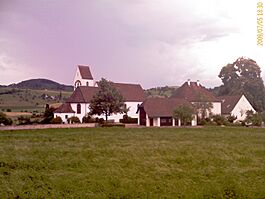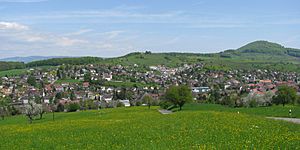Magden facts for kids
Quick facts for kids
Magden
|
||
|---|---|---|

Magden village and church
|
||
|
||
| Country | Switzerland | |
| Canton | Aargau | |
| District | Rheinfelden | |
| Area | ||
| • Total | 11.02 km2 (4.25 sq mi) | |
| Elevation | 325 m (1,066 ft) | |
| Population
(Dec 2020 )
|
||
| • Total | 3,872 | |
| • Density | 351.36/km2 (910.0/sq mi) | |
| Postal code |
4312
|
|
| Surrounded by | Arisdorf (BL), Hersberg (BL), Maisprach (BL), Möhlin, Nusshof (BL), Olsberg, Rheinfelden, Wintersingen (BL) | |
Magden (called Magde in Swiss German) is a small town, also known as a municipality, in Switzerland. It is part of the Rheinfelden district in the canton of Aargau.
Magden is located about 3 kilometers (less than 2 miles) south of the town of Rheinfelden. In ancient Roman times, it was known as Magdinium. The famous Magdalener spring is found here. This spring still provides water for the Feldschlösschen brewery in Rheinfelden, which is now owned by the Carlsberg company.
Contents
History of Magden
Magden has a very long history, with signs of people living here since the Stone Age.
Early Settlements
The very first evidence of people living in Magden comes from a paleolithic/neolithic village. This means people lived here thousands of years ago, even before written history! Some items from the Roman era have also been found scattered around Magden. Two empty graves from the Alamanni people were discovered near the village too.
From Medieval Times to Modern Switzerland
The name Magden first appeared in records in 804 as in curte Magaduninse. For many centuries, powerful families ruled over Magden. First, the Counts of Thierstein were in charge, and then the famous Habsburgs took over. They controlled Magden until 1797.
In 1803, Magden became part of the new Canton of Aargau. This happened because of something called the Act of Mediation. Magden was part of a region known as Fricktal. The first school in Magden opened its doors in 1761, showing how important education became.
Churches and Religious Changes
The village church of St. Martin was built a very long time ago, during the Frankish Empire. In 1036, a count named Ulrich I von Lenzburg gave the right to choose the church's priest to a monastery. Later, in 1351, these rights were given to the Olsberg monastery. The church building you see today was built in 1620.
When a monastery in Rheinfelden was closed in 1811, three of its altars were moved to Magden's church. In 1872, many people in Magden changed their religion and joined the Christian Catholic Church of Switzerland. Because of this, the Christian Catholic community took over the church in 1906. Later, a Roman Catholic church was built in 1969, and a Reformed church was built in 1976.
Iglingen Monastery
Near Magden, there was also a place called Iglingen monastery and its Chapel of St. Niklaus. It was first mentioned in 1360. A group of lay brothers (religious men who are not priests) moved there in 1465. The monastery church was dedicated in 1509. Later, in the late 1500s, a place for nuns was added. Sadly, the church burned down in 1860, and only the choir (the part where the singers sit) survived. This part was then turned into a small chapel.
Economic Changes
Towards the end of the 1800s, Magden changed its farming focus. People started growing a lot of fruit, especially cherries, instead of the traditional vineyards (grape farms). After World War II, many new jobs became available in the chemical industry in the Fricktal area.
Geography of Magden
Magden covers an area of about 11.01 square kilometers (4.25 square miles).
Land Use
A big part of Magden's land is used for farming. About 47.1% of the area is farmland. Forests cover a large portion too, making up about 41.9% of the land. The rest of the land, about 11.0%, is used for buildings and roads. A tiny bit, 0.2%, is rivers or lakes.
Most of the forested land is dense forest. For farming, people grow crops, use land for pastures (where animals graze), and have orchards or vineyards.
Village Layout
Magden is located in the Rheinfelden district, within the Fricktal region. The main village of Magden is a haufendorf village. This means it's an irregular, unplanned village with buildings packed closely together around a central area. Magden also includes two smaller settlements called Igligerhof and Deschlikon.
Magden's Coat of Arms
The blazon (official description) of Magden's coat of arms shows a silver shield with a green apple tree that has red apples. On either side of the apple tree are two green grapevines with stakes. All these plants grow from a green base. The two grapevines are a special reminder of the old Roman vineyards that were found in the village.
People of Magden (Demographics)
Magden has a population of about 3,249 people (as of December 2004).
Population Growth and Languages
Over ten years (from 1997 to 2007), Magden's population grew by 18.4%. Most people in Magden speak German, about 92.9% of the population. French is the second most common language (1.5%), followed by English (1.4%).
Age Groups
Looking at the age of people in Magden (as of 2008):
- Children aged 0-9 make up 10.4% of the population.
- Teenagers aged 10-19 make up 13.5%.
- Young adults aged 20-29 make up 8.9%.
- Adults aged 30-39 make up 12.0%.
- Adults aged 40-49 make up 18.3%.
- Adults aged 50-59 make up 13.5%.
- Seniors aged 60-69 make up 12.9%.
- Seniors aged 70-79 make up 7.3%.
- People aged 80-89 make up 2.8%.
- People aged 90 and older make up 0.4%.
Historical Population
Here's how Magden's population has changed over time:
| Historical population | ||
|---|---|---|
| Year | Pop. | ±% |
| 1768 | 689 | — |
| 1850 | 1,075 | +56.0% |
| 1900 | 894 | −16.8% |
| 1950 | 975 | +9.1% |
| 1960 | 1,107 | +13.5% |
| 2000 | 3,043 | +174.9% |
Important Heritage Site
The ancient settlement at a place called Strick is very important. It is listed as a Swiss heritage site of national significance. This means it's a protected historical place for the whole country.
Economy and Jobs
Magden has a healthy economy with people working in different areas.
Types of Jobs
In 2005, there were 78 people working in the primary economic sector. This means they worked in farming, forestry, or fishing. There were 23 businesses in this sector.
About 190 people worked in the secondary sector. This includes jobs in manufacturing and construction. There were 34 businesses in this area.
The largest group, 318 people, worked in the tertiary sector. This includes jobs in services like shops, schools, healthcare, and offices. There were 72 businesses in this sector.
Commuting to Work
In 2000, 1,481 people who lived in Magden had jobs. Most of them, about 78.9%, worked outside of Magden. However, 232 people came into Magden to work. For getting to work, 19.2% of people used public transportation, and 54.1% used a private car.
Religion in Magden
Based on a census from 2000, people in Magden follow different Christian faiths:
- About 27.5% of the population were Roman Catholic.
- About 40.1% belonged to the Swiss Reformed Church.
- About 12.91% of the population belonged to the Christian Catholic faith.
Education in Magden
Education is important in Magden.
Schools and Learning
About 85.4% of adults (aged 25-64) in Magden have completed either high school or gone on to higher education like university. In the 2008/2009 school year, there were 281 students in primary school and 125 students in secondary school in the municipality.
The Library
Magden also has a library called Mediathek Magden. In 2008, the library had 10,025 books and other media items. It loaned out 32,055 items that year. The library was open for 184 days and for an average of 9 hours each week.
See also
 In Spanish: Magden para niños
In Spanish: Magden para niños







